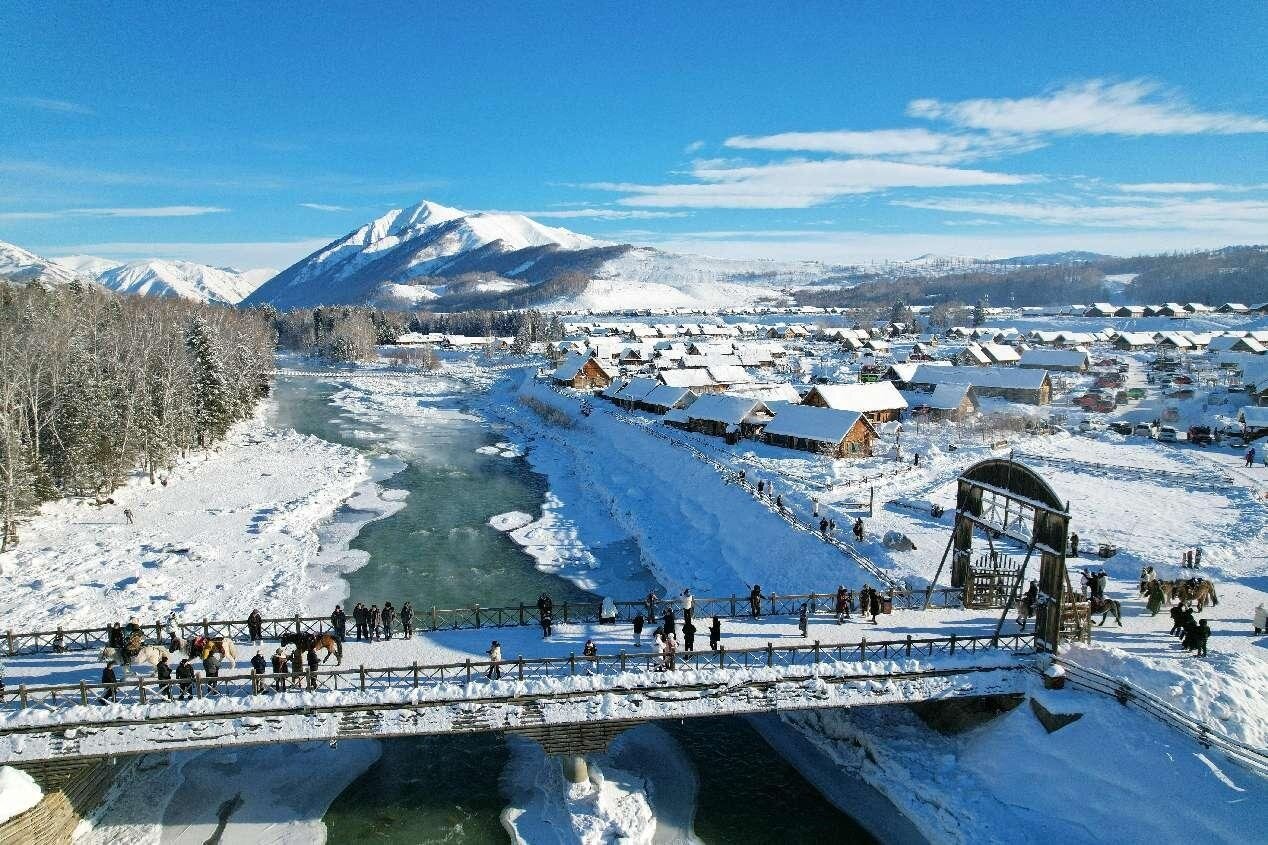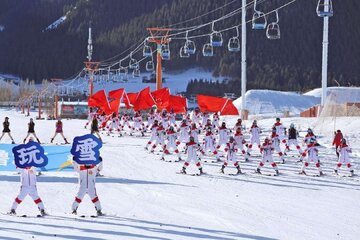At the Jiangjun Mountain ski resort in Altay, Xinjiang, Huang Jianzhong and his family from Shenzhen, south China's Guangdong province, put on skiing equipment and got ready to go on the slopes with their coach.
"In previous winters, we came here for only sightseeing. This year we specifically hired a coach to teach my children how to ski," Huang told People's Daily. Nowadays, more and more tourists, like Huang and his family, would visit Xinjiang to experience the joy of winter sports.
Lyu Yaoping, a coach from a skiing training center at the Jiangjun Mountain ski resort, told People's Daily that the training center had only about 50 coaches when she joined it four years ago, and the number today has exceeded 180.
Besides, the number of relevant venues has also increased year by year. Today, Xinjiang is home to 101 ski resorts, 27 indoor ice rinks and 60 ice-snow amusement parks.
In addition to winter sports, Xinjiang fully utilizes its resources such as scenic spots, parks, ice and snow venues, and themed towns to host events such as ice and snow photography exhibitions, ice sculpture exhibitions, and snow sculpture exhibitions. The public's enthusiasm for ice and snow continues to rise.
Chi Shaoquan, deputy governor of Fuhai county in Altay, noted that the county was preparing to host a winter fishing festival that would take place soon. So far, Fuhai county has held 16 sessions of the festival, benefiting both the aquaculture and tourism industries.

Read More:
The fruits of Chinese investment in Uyghur art and culture in Xinjiang
How did Kashgar Turned to a Symbol of China's Ancient Cultural Heritage?
Book featuring Xi Jinping’s articles, speeches published in Persian
In a workshop in Altay, Kuanishbek Slanbek, a master craftsman of ancient fur skis production, was busy making his products. Altay is the birthplace of skiing, and fur skis were an important tool for winter production and daily life in ancient times. Today, the craft of fur ski-making has regained vitality thanks to winter sports.
According to Kuanishbek Slanbek, those who purchase the fur skis are mainly skiing enthusiasts. They use the skis to experience local-style skiing, and some buy the products as souvenirs.
It takes about 15 days to make a pair of fur skis, which are priced at around 1,000 yuan ($140). Since the beginning of this winter, Kuanishbek Slanbek has already made 60 pairs and still has pending orders.
"I have trained a group of young people to make fur skis. This has not only increased our income, but also ensured the inheritance of this craft," Kuanishbek Slanbek said.
Dozens of workers from a bedding company in Habahe county, which is over 100 kilometers away from Kuanishbek Slanbek's workshop, were also rushing to fulfill orders. The company just finished producing 5,000 pieces of ski suits lately, and now they have received a new order for 12,000 pieces more.
A ski equipment company in Urumqi was also ramping up production. The company had to deliver three "magic carpets" to Kyrgyzstan in January next year.
"We mainly produce ski lifts, 'magic carpets,' snowmaking equipment, and snowboards. Our products not only meet the needs of local ski resorts but also sell to other regions," said Liao Yuan, the company's manager. According to him, the sales volume of the company has been increasing at an average of 30 percent per year.
Xinjiang enterprises have made inroads into ice and snow equipment manufacturing, covering personal equipment such as skiing suits, gloves, and snowboards, as well as specialized equipment for ski resorts like tow ropes, magic carpets, and ski lifts. This development has become an important part of the ice and snow industry in Xinjiang.
Helatibek Musai, a villager from Fuyun county, Altay, has been working at the international ski resort in Koktokay for five years. Every winter, he and his wife head to work early at the resort.
"There's no more leisure time now, as we are all busy making money! I'm the snowmaking supervisor and my wife is the guest room supervisor. Together, we earn over 10,000 yuan per month," the man told People's Daily.
In 2018, the construction of the international ski resort commenced, and the facility officially opened for business in 2020. Since then, it has received over 1 million tourists.
Currently, the ski resort provides stable employment for more than 210 local farmers and herdsmen, with an average annual income of 32,000 yuan per person. Additionally, it has also created flexible job opportunities for over 7,000 people in the surrounding area.
With the increasing number of tourists, more and more local specialty products in Xinjiang have found a market. For instance, a cultural and creative park in Shuixigou township, Urumqi county, has built "bubble houses" that come with heating facilities, so that tourists can get a view of the beautiful sceneries outside these transparent "bubbles" in winter. The park also provides free stalls for local villagers to sell agricultural and sideline products, as well as handicrafts.
"These camel ornaments, felt purses, and felt jewelry boxes were all handmade by female members of our cooperative. Through selling these handicrafts, each of us earns around 4,500 yuan per month," said Hatima Ened, president of the cooperative in Urumqi county.

Hatima Ened, also an inheritor of the intangible cultural heritage item of Kazakh embroidery, told People's Daily that the booming tourism at the cultural and creative park has enabled many local families to increase their income.
The 21st Silk Road Ice and Snow Festival in Urumqi kicks off in northwest China's Xinjiang Uygur autonomous region, Dec. 23, 2023. Photo shows a skiing performance staged during the opening ceremony of the event. (Photo by Xia Fangfang/People's Daily Online)
Tourists visit a village in Altay, northwest China's Xinjiang Uygur autonomous region, Dec. 22, 2023. (Photo by Aldak Beshan/People's Daily Online)
A tourist skis at a ski resort in Changji Hui autonomous prefecture, northwest China's Xinjiang Uygur autonomous region, Dec. 20, 2023. (Photo by Tao Weiming/People's Daily Online)


Your Comment